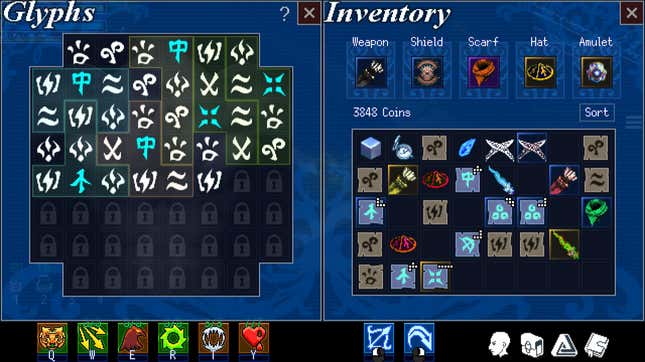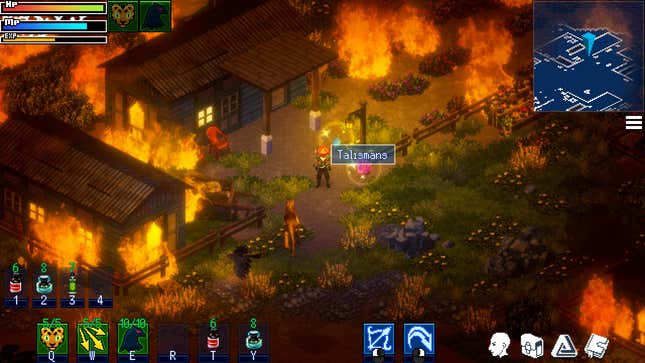I can’t imagine how daunting it must be to start creating a Diablo-style action RPG. Not only are they so few in number, but those that are known are behemoths. Diablo, obviously, then Titan Quest, Torchlight, Grim Dawn… Who would deliberately want to step into its shadow, especially with Diablo IV coming out next week for a chorus of stellar reviews. Now imagine trying anyway, when there are only two people making the game. It’s Ghostlore, which just came out on Xbox Game Pass, and wow, it succeeds.
To be a Diablo-like, there are a few checkboxes. You need an isometric perspective, thousands of enemies to attack with an ever-increasing number of skills, portals to shops, and most importantly, a nearly endless amount of loot. All of these demands are incredibly difficult for any developer, requiring not only a frightening sheer volume of content to create, but also a cobweb of aspects to balance perfectly. I can immediately see why most wouldn’t try. And that only adds to my respect for developers Andrew Teo and Adam Teo (unrelated), who were undeterred.
Ghostlore achieves all of the above, only slipping slightly in difficulty, and even adds a few unique twists to the format. This is largely due to a lot of common sense when it comes to range.
Screenshot: Andrew Teo/Adam Teo/Kotaku
Bringing action RPG to Southeast Asia
Described as an “Eastpunk” game by its creators, Ghostlore draws inspiration from South Asian folklore, including the mythologies of Singapore, Malaysia, China and Indonesia, set in a particular blend of the modern world and planes and forests infested with monsters. Rendered in beautifully drawn sprites, the world has a smart 90s look, while playing like a classic ARPG, delivering all the enemy- and loot-busting antics you’ve come to expect from the genre. Ghostlore then adds unique enemies, including an intriguing bonus system and the ability to combine classes to create new sets of skills and attacks.
For the most part, you know what you’re getting here. There is a central town with quest givers, merchants and that person who will remove the gems from your gear or the gear from your gems. You then go off to different grayed out regions, exploring, attacking and looting, leveling up, changing speed, getting mad that you just found a better shield just after spending all your money and gems to upgrade your current one, and blowing health and mana potions like a tense wizard.

Screenshot: Andrew Teo/Adam Teo/Kotaku
But between these familiar aspects lie some really interesting ideas. (Don’t hate me if you’ve seen them elsewhere – they were new to me.) The first is the Glyph system. Glyphs can be found among the loot in large quantities, each with a boost property, such as, for example, “+12% increase in minion HP” or “+81 MP”. These are placed in a tiled grid next to your inventory, in which new spaces unlock as you level up. (By the end of the game, I had 49 of the total 60 open.) However, you can also find Compound Glyphs, which are five-tile shapes, pentominoes if you will, which then enhance the properties of all other glyphs that fall into their tiles. It’s a mini-game in itself, trying to fit your best compound glyphs into the best possible arrangement in the grid. And for min-maxers, it’s manna from heaven.
Another fantastic idea that I want to see copied everywhere is the way Ghostlore handles classes. At first, you choose from one of six – Sentinel, Feral, Exorcist, Hashashin, Geomancer, and Adept – then unlock slots in another grid that allow you to choose from their selection of skills. You can swap them whenever you want and quickly unlock more slots to include more skills. Or, you can choose to insert a skill modifier or class bonus, the former empowering other skills on that grid row, the latter being unlocked for every four filled tiles of that class. But it gets much more interesting when you reach level 15.
At this point, you can add a second class to your character and thus also access all of their skills. But in a splendid feature, if you place particular skills from either class next to each other in the grid, they combine to create a third ability, unique to that specific class combination. Place Summon Sentinel Crows next to Feral Unleash, and the two combine to create Summon Sunbirds. They are more powerful creatures, used to help when attacking enemies. Or place the Exorcist’s Exorcise next to the Dervish of Hashashin, and the result is Summon Taming Sari, and a collection of possessed blades fighting alongside you. Reach level 30 and you can add a third and final class, and start making even more combinations in your skill grid.

Screenshot: Andrew Teo/Adam Teo/Kotaku
The trouble with Diablo likes
So many aspects to tweak will delight those who play Diablo-likes to meticulously hone their characters. But also, for those who just want to hit stuff with a stick, anything is possible to use with a more sloppy attitude and I just hope that helps.
This brings us to Ghostlore’s big problem: difficulty. There’s not enough. It’s important to read this knowing that I’m usually the person who advocates for better easy modes, or is furious at the difficulty of spike-shaped bosses, so it’s not about bravado or elitism. It’s been way too easy for way too long, so much so that for the first 25 levels I never used a health potion. (I’m level 39 now, playing post-game content.) In this genre, it’s not necessarily a terrible problem, given how many players play ARPGs almost like idle games, something to click while listening to a podcast. But it’s definitely more fun once it starts to get more complicated. (It should be noted that there is a permadeath mode, however.)
Complete the main story, however, and you’ll gain access to entirely new areas that offer a much higher degree of challenge, which is beautiful. There’s also local co-op, and of course the replayability of trying out different class builds.
Ghostlore clicked for me just like Titan Quest, but on a smaller scale. But that’s also a selling point here – it’s not going to take over your life like Diablo IV might next week, but rather give you a shorter burst of fun and for a fraction of the price.
.
Article source https://kotaku.com/diablo-iv-ghostlore-action-rpg-game-pass-xbox-steam-1850490882

